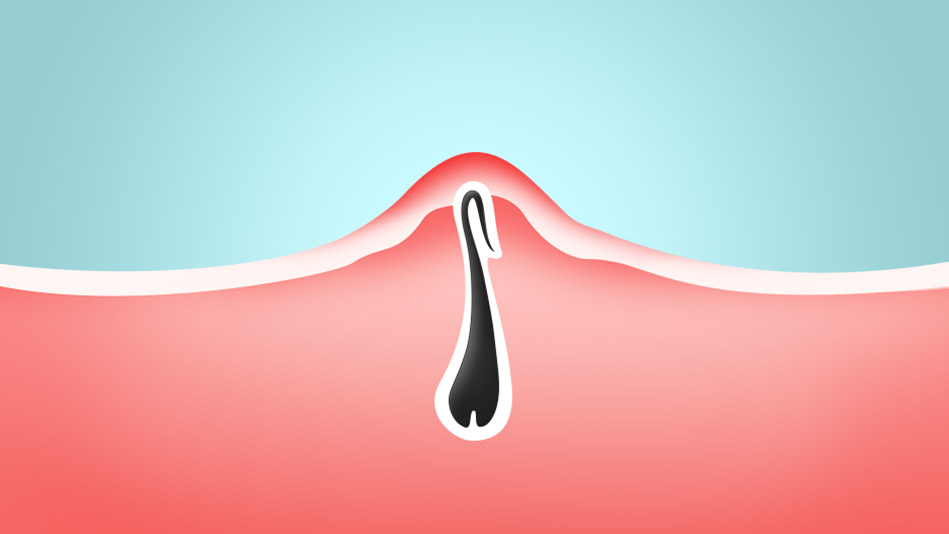This Is How Dermatologists Get Rid of Ingrown Hairs
Those small bumps can become much bigger problems if you don't handle them the right way.

Illustration: David Wyffels
You should only try to remove an ingrown hair at home if: 1) It's a one-off, not one of many; 2) the hair has already broken through the surface of the skin; and 3) you have a sterile needle you can use to pull it out. If those conditions apply—and all three are nonnegotiable— you can try to remove it, says Nada Elbuluk, MD, a board-certified dermatologist at NYU Langone Medical Center, in New York, who's seen many cases of at-home ingrown removal gone awry. Here’s how to do it the right way: lift up the tip of the hair with the needle, catch the hair in the eye of the needle, then give the needle a turn and pull the hair out.
If the hair does not come out easily, don't go on an excavation mission. That can lead to scarring, dark spots or infection, especially if you're using a non-sterile tool like your trusty (and much-used) tweezers, says Leslie Baumann, MD, a board-certified dermatologist and founder and CEO of the Baumann Cosmetic & Research Institute, in Miami. She noticed that patients' frustration levels would spike after three failed attempts at removing the hair—they'd start to dig at it and cause damage. So she came up with a "three strikes and you're out" rule for at-home removal. Both Elbuluk and Baumann recommend a needle over tweezers (less temptation to dig around and force the hair out).
If you get ingrown hairs frequently, or the hair is still trapped under the skin (or you don't have a sterile needle), see your dermatologist. If they can't remove it, they'll recommend products with chemical exfoliators like salicylic acid or glycolic acid to remove the top layer of dead skin so the hair frees itself and you reduce the chance of getting more ingrowns. If your ingrown hair(s) looks more like acne, with lots of redness and potentially puss, your doctor might also suggest using a product with benzoyl peroxide to help resolve the issue.
A few more tips to prevent ingrown hairs:
- Some women get ingrown hairs on their face, and retinoids are another good exfoliating option in that case. (Don't use these products on your bikini area, though, because the skin there is too sensitive, says Elbuluk.)
- Shave in the direction of hair growth instead of against it.
- If your body hair is curly, which makes it more likely that the hair will curl before it breaks through the skin or curl back in afterward, try spacing out your hair removal. The more frequently you shave, wax or pluck, the more chances for hair to grow back incorrectly. You could also talk to your doctor about more permanent options like laser hair removal.
- Hair-removal techniques like waxing or plucking can lead to ingrowns because they rip hair out at the root, says Elbuluk. If you tend to get ingrown hairs after using either method, try depilatory creams or shaving (with the grain, of course) instead.
If the hair does not come out easily, don't go on an excavation mission. That can lead to scarring, dark spots or infection, especially if you're using a non-sterile tool like your trusty (and much-used) tweezers, says Leslie Baumann, MD, a board-certified dermatologist and founder and CEO of the Baumann Cosmetic & Research Institute, in Miami. She noticed that patients' frustration levels would spike after three failed attempts at removing the hair—they'd start to dig at it and cause damage. So she came up with a "three strikes and you're out" rule for at-home removal. Both Elbuluk and Baumann recommend a needle over tweezers (less temptation to dig around and force the hair out).
If you get ingrown hairs frequently, or the hair is still trapped under the skin (or you don't have a sterile needle), see your dermatologist. If they can't remove it, they'll recommend products with chemical exfoliators like salicylic acid or glycolic acid to remove the top layer of dead skin so the hair frees itself and you reduce the chance of getting more ingrowns. If your ingrown hair(s) looks more like acne, with lots of redness and potentially puss, your doctor might also suggest using a product with benzoyl peroxide to help resolve the issue.
A few more tips to prevent ingrown hairs:
- Some women get ingrown hairs on their face, and retinoids are another good exfoliating option in that case. (Don't use these products on your bikini area, though, because the skin there is too sensitive, says Elbuluk.)
- Shave in the direction of hair growth instead of against it.
- If your body hair is curly, which makes it more likely that the hair will curl before it breaks through the skin or curl back in afterward, try spacing out your hair removal. The more frequently you shave, wax or pluck, the more chances for hair to grow back incorrectly. You could also talk to your doctor about more permanent options like laser hair removal.
- Hair-removal techniques like waxing or plucking can lead to ingrowns because they rip hair out at the root, says Elbuluk. If you tend to get ingrown hairs after using either method, try depilatory creams or shaving (with the grain, of course) instead.



